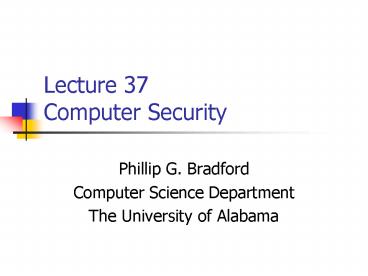Lecture 37 Computer Security PowerPoint PPT Presentation
1 / 26
Title: Lecture 37 Computer Security
1
Lecture 37Computer Security
- Phillip G. Bradford
- Computer Science Department
- The University of Alabama
2
Gorgas House CS Party!
- Congratulate Seniors
- CS Advisory Board
- Thursday 1-May _at_ 600pm
- Gorgas House
- Check out
- http//www.cs.ua.edu/9-gorgas.htm
3
Announcements
- Talk Friday
- Professor Michiel Smid
- Carleton University
- Approximating geometric bottleneck shortest
paths - Prof. Smid will be discussing foundations of
theory that lead to important applications
4
Announcements
- Click Here for a very important Announcement !
- Any students whom are interested, I will offer my
full support! - Please consider this!
5
Announcements
- Final Exam
- Comprehensive
- Outline
- Practice Exam
- Graduate Projects
- Im here to help
- Let me know what I can do!
6
Project
- How is it going?
- Team leads for Friday
- How to proceed
- Top-Down
- Start with the diagram on the slide of the last
lecture! - Build classes suiting the diagram
7
Cryptographic Systems
- Basics
- Negotiation of Security Parameters
- Mutual Authentication
- Private Key Exchange
- Communication
- Note TLS (SSL 3.1) is Transport Layer Security
- What about SUB-Transport layer?
8
Network Encryption
- Link-Level Encryption
- Pros traffic analyses
- Cons Decrypting at Routers
- End-to-End Encryption
- Pros Routers can be routers
- Cons traffic analyses
9
Introduction to IP Security
- Sub-Transport-Layer
- IPSec Architecture (RFC 1636)
- Examples for LAN and WAN
- Need to build VPNs
- Local Connectivity to secure ISPs
- Trusted Partners
- E-Commerce Security, payments, etc.
10
Introduction to IPSec
- Recall ISO Layers
- Physical cables
- Data-link physical frames of data
- Network address/route specifications
- Transport reliable end-to-end packets
- Internet TCP and UDP
- Session how a session is run
- Presentation presenting the data
- Application programs
11
Introduction to IPSec
- IPsec is before the transport layer
- Why?
- It is all physical security earlier
- Though, addressing could be free of geographical
information - Software uses TCP or UDP to transmit IP
datagrams, so having IPSec before TCP and UDP
makes it transparent! - Easy to make VPNs, etc.
- Compare to TLS (SSL)
12
IPSec Parts
- Architecture
- ESP (Encapsulating Security Payload)
- AH (Authentication Header)
- Encryption Algorithm
- Authentication Algorithm
- Key Management
13
IPSec Modes
- Tunnel Mode
- Pack your IP packets in other IP packets
- Like Link-level encryption
- Maybe behind a firewall, etc.
- Routers cant get data or details
- Transport Mode
- End-to-End encryption
- For the data portion of the IP datagram
- AH mode authenticates parts of the IP header
14
AH Header
- Data integrity Authentication of IP datagrams
- Prevent modifications to packets
- What does this mean?
- Prevents Replay attacks
- Sequence number counter
- An SA only has 232 -1 packets in sequence
- Must establish another SA after it runs out
15
AH Header
- Receiving Window
- Receiver accepts packets stores them for
sequencing - Recall IP does not guarantee order or arrival
- UDP
- AH Message Digest
- Fixed IP fields
- Eg., no TTL (Time to live)
- All data
16
AH Function
- Must Implement
- HMAC-MD5-96 with 128 bit key
- HMAC-SHA-1-96
- Why these hash functions?
- Faster than many symmetric encryptions
- MD5 by Rivest
- No key, just message digest
- From 512 bits to 128 bits
17
AH Function MD5
- MD5, cont
- Every bit of hash output depends on every bit of
input - Rivests conjecture in RFC
- Challenge of finding two colliding inputs 264
ops - Pre-image Challenge of finding input given an
output is 2128 ops - Why are these different?
- SHA-1 Secure Hash Algorithm
18
AH Function HMAC
- MAC message authentication code
- HMAC uses some Hash function
- Hash functions dont have keys
- HMAC integrates a key into a specified Hash
function - HMACk H (K XOR opad) Y
- Y H(K XOR opad) M
- Where opad 010110101 b/8 times
- And ipad 00110110 b/8 times
19
ESP Format
- SPI security parameter index
- Sequence number
- Payload data
- Padding
- Padding length
- Next header
- Authentication data
- Denotes encrypted
20
ESP Ciphers
- Must have
- DES in CBC mode
- Other methods
- Three-key triple DES
- Three-key triple IDEA
- IDEA
- CAST
- Others
21
SA ESP
- Uses authentication data field for
authentication, see AH - ESP Transport Mode
- Encrypt IP datagrams
- ESP header in the data field of the IP datagram
- Authentication covers all of ESP data
- Including header
22
SA ESP
- Tunnel Mode ESP
- Used for VPNs
- Firewalls connecting a potential VPN
- Encapsulate ESP encrypted IP datagram packet
- Into other IP packets routed only to the VPN
front-end firewalls
Internet
Proxy Firewall
Proxy Firewall
23
IPSec Key Management
- Manual
- Assign keys by hand to different parts of network
- Small Static situations
- Automated
- On-demand key generation
- ISAKMP/Oakley
24
IPSec Key Management
- Oakley Key Determination
- Uses Diffie-Hellman other measures
- ISAKMP Internet Security Association and Key
Management Protocol - Framework for Internet Key management
25
ISAKMP
- Allows Conference Calls
- Multiple key sets of Diffie-Hellman
- Authenticates Diffie-Hellman key exchanges
- Mechanisms for stopping
- Replay Attacks
- Clogging Attacks
26
Network IssuesPoints of Vulnerability
- Addressing Schemes
- IEEE 802 LAN 16 to 48 bit addressing
- Ethernet 48 bit addressing
- X.25 12 base-10 digit addressing
- IPv4 32 bits, source and destination each
- IPv6 128 bits, source and destination each
- Different Data Sizes

